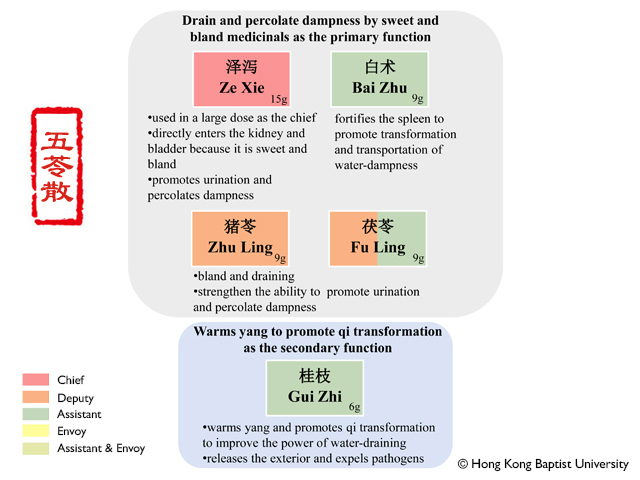|
|
 Chinese Medicinal Material Chinese Medicinal Material
|
| 【Chinese Name】 |
五苓散
|
| 【Phonetic】 |
Wu Ling San
|
| 【English Name】 |
Five Substances Powder with Poria |
| 【Classification】 |
Dampclearing formulas |
| 【Source】 |
《Treatise on Cold Damage》Shang Han Lun《傷寒論》 |
| 【Combination】 |
Polyporus (Zhu Ling) 18 zhu (9g), Alismatis Rhizoma (Ze Xie) 1 liang and 6 zhu (15g), Atractylodis Macrocephalae Rhizoma (Bai Zhu) 18 zhu (9g), Poria (Fu Ling) 18 zhu (9g), Cinnamomi Ramulus (Gui Zhi) 0.5 liang (6g) |
| 【Method】 |
Grind the ingredients into powder and take 6-10g. It can also be prepared as a decoction. After ingestion, drink hot water to induce a light sweat. |
| 【Action】 |
Promotes urination and percolates dampness, warms yang and promotes qi transformation. |
| 【Indication】 |
Wu Ling San is indicated for water amassment syndrome due to dysfunction of bladder qi transformation. The symptoms are dysuria, headache with mild fever, thirst and desire to drink, vomiting as soon as drinking, throbbing below the navel, spitting, dizziness, shortness of breath, cough, edema, and diarrhea. The tongue coating is white and the pulse is either floating or floating and rapid. |
| 【Pathogenesis】 |
While the indications are various this pattern has the same pathogenesis of excessive internal water-dampness and dysfunction of bladder qi transformation. In the《Treatise on Cold Damage》, this formula is used for water amassment syndrome. It is caused by external pathogens in the taiyang entering the corresponding fu-organ along the channels that leads to a disease involving both the taiyang channel and its fu-organ. External pathogenic contraction in the taiyang gives rise to headache and mild fever. The failure of bladder qi transformation leads to dysuria. Retention of water blocks yang qi and results in qi failing to diffuse fluids. This in turn leads to the failure of fluid ascending into the mouth causing thirst with a desire to drink. Water stagnation in the lower jiao hinders the ability for fluids that are drunk to distribute. This causes water counterflow marked by vomiting as soon as drinking. It is also called water-up rushing pattern. Excessive water-dampness spills over the skin manifesting edema. When water-dampness descends into the large intestine, diarrhea is the result. When water-dampness accumulates in the stomach and intestine, a disharmony between the ascension and descending will result. In this case, a conflict between the clear and turbid will manifest vomiting and diarrhea. When water accumulates in the lower jiao, water and zheng qi conflict with each other and cause throbbing below the navel. When water up rushes and invades the upper jiao, lung qi is blocked. This causes shortness of breath and coughing. The therapeutic methods are to promote urination and percolate dampness; however, methods to warm yang and promote qi transformation are also used. |
| 【Application】 |
1. Essential pattern differentiation
Wu Ling San is a common formula used to promote urination and qi transformation. This clinical pattern is marked by dysuria, white tongue coating, floating or slow pulse.
2. Modern applications
This formula may be used in the following biomedically defined disorders when the patient shows signs of retention of water and dampness: edema in acute or chronic nephritis, ascites in liver cirrhosis, cardiac edema, acute enteritis, urinary retention, and hydrocephalus. |
| 【Additonal formulae】 |
1. Si Ling San (Four Substances Powder with Poria 四苓散)
[Source]《Teachings of [Zhu] Dan-xi》Dan Xi Xin Fa《丹溪心法》
[Ingredients] Wu Ling San minus gui zhi
[Preparation and Administration] Grind the medicinals into a fine powder. One dose is 4 qian (12g). Prepare it as a decoction.
[Actions] Fortifies the spleen and percolates dampness.
[Applicable Patterns] Retention of water-dampness due to deficiency of the spleen and stomach. Symptoms include: scanty dark urine and loose stool.
2. Wei Ling Tang (Stomach-Calming Poria Decoction 胃苓湯)
[Source]《Effective Formulas from Generations of Physicians》Shi Yi De Xiao Fang《世醫得效方》
[Ingredients] Wu Ling San plus Ping Wei San
[Preparation and Administration] Mix these medicinals and decoct them with su zi and wu mei.
[Actions] Dispels dampness and harmonizes the stomach, moves qi, and promotes urination.
[Applicable Patterns] Cold damage of the spleen and stomach in-between summer and autumn leading to the failure to separate the clear and turbid. Symptoms include: watery diarrhea, edema, abdominal distension, and dysuria.
3. Yin Chen Wu Ling San (Five Substances Powder with Poria Plus Virgate Wormwood 茵陳五苓散)
[Source]《Essentials from the Golden Cabinet》Jin Gui Yao Lue《金匱要略》
[Ingredients] Wu Ling San plus double yin chen
[Preparation and Administration] Prepare it as a decoction.
[Actions] Drains dampness and relieves jaundice.
[Applicable Patterns] Damp-heat jaundice with dysuria with more dampness than heat . |
|
|

|




